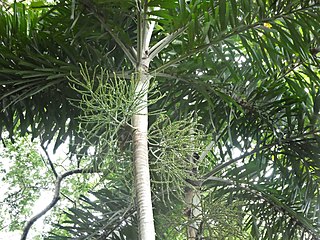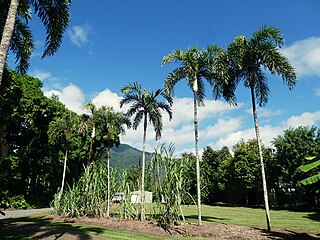
Idiospermum is a monotypic genus in the family Calycanthaceae. The sole included species is Idiospermum australiense − commonly known as idiotfruit, ribbonwood, or dinosaur tree − which is found only in two small areas of the tropical rainforests of northeastern Queensland, Australia. It is a relic of the ancient forests of Gondwana, surviving in very localised refugia for 120 million years, and displaying features that are almost identical to fossil records from that time. As such it provides an important insight into the very early evolution of flowering plants.
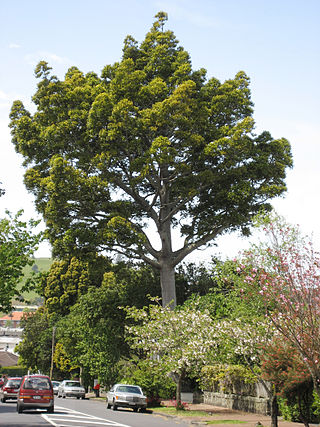
Agathis robusta, commonly known as the Queensland kauri (pine) or smooth-barked kauri, is a coniferous tree in the family Araucariaceae. Although sometimes called a pine it is not a true pine, having leaves rather than needles. It has a disjunct distribution, occurring in Papua New Guinea and Queensland, Australia. Populations in Papua New Guinea may be treated as the distinct species Agathis spathulata.
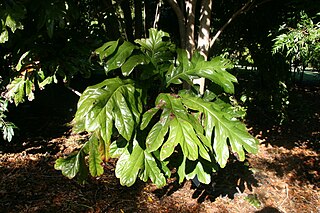
Athertonia is a monotypic genus of plants in the family Proteaceae. The sole described species is Athertonia diversifolia, commonly known as Atherton oak, athertonia, creamy silky oak or white oak. It is endemic to a small part of the Wet Tropics of Queensland, Australia. A relative of the macadamia, it has potential in horticulture and the bushfood industry.

Archontophoenix alexandrae, commonly known as Alexandra palm, king palm, Northern Bangalow palm, or feather palm, is a palm endemic to Queensland, Australia. It was named in honour of Princess Alexandra of Denmark, but is often erroneously referred to by the misnomer Alexander palm.

Dypsis ambositrae is a species of flowering plant in the family Arecaceae. It is found only in Madagascar where it is threatened by habitat loss.

Hedyscepe canterburyana, the big mountain palm or umbrella palm, is the sole species in the genus Hedyscepe of the family Arecaceae. It is endemic to Lord Howe Island, Australia and is threatened by habitat loss. It is a solitary palm with a distinct crownshaft, and bears unisexual flowers of both sexes. With the Rhopalostylis palms of Norfolk Island and New Zealand it forms the botanic subtribe Rhopalostylidinae. If differs from Rhopalostylis in minor floral details including having more than six stamens, and in being protandrous rather than protogynous. The two genera were formerly included in Archontophoenicinae until a recent revision. In some molecular phylogenetic analyses, Hedyscepe was found to be nested in the New Caledonia endemic Basselinia.

Ptychosperma macarthurii, commonly known as the Macarthur palm, is a species of tree in the palm family Arecaceae. Its native range is northern Cape York Peninsula in Queensland with a number of disjunct populations in the Northern Territory and New Guinea. The species has been widely planted in tropical areas and is commonly grown as an indoor plant.

Semecarpus australiensis, commonly known as the tar tree, native cashew, marking nut, or cedar plum, is a species of tree in the cashew, sumac and mango family Anacardiaceae, native to parts of Melanesia and northern Australia. Contact with the plant can cause serious allergic reactions, a common characteristic of this family.

Calamus australis, commonly known as wait-a-while, hairy mary or lawyer cane, is a plant in the palm family Arecaceae which is endemic to the rainforests of north east Queensland, Australia. Like other species in the genus Calamus, this is a climbing plant with a very long and flexible stem. It uses sharp strong hooks on the fronds and tendrils to attach itself to other vegetation, such as taller established trees, thus gaining support that enables it to grow higher towards the canopy. This species is very similar to C. radicalis, with which it coexists, but is smaller in almost all respects.

Phaleria clerodendron, commonly known as scented daphne, scented phaleria or rosy apple, is an evergreen tree or tall shrub in the family Thymelaeaceae. It is endemic to the rainforests of north-eastern Queensland, Australia.

Dysoxylum pettigrewianum, commonly known as spur mahogany, spurwood, or Cairns satinwood, is a large tree in the family Meliaceae. It is native to the rainforests of Malesia, Papuasia and Queensland. In Queensland it occurs only in a small part of the northeast coast.

Ptychosperma elegans, commonly known as the solitaire palm, is a very slender palm endemic to Queensland in Australia. In the nursery trade and in the United States it may be confusingly referred to as Alexander palm, which is an often-used but misnomered name of another Australian palm species Archontophoenix alexandrae, the Alexandra palm.

Buckinghamia celsissima, commonly known as the ivory curl tree, ivory curl flower or spotted silky oak, is a species of tree in the family Proteaceae. It is endemic to the tropical rainforests of northeastern Queensland, Australia.

Palaquium galactoxylum, commonly known as Cairns pencil cedar, Daintree maple or red silkwood, is a species of very large tree in the family Sapotaceae which is endemic to rainforests of New Guinea and northern Australia. It can produce spectacularly large buttress roots.

Gardenia actinocarpa is a rare and endangered plant in the madder family Rubiaceae that grows in a very restricted area within the Wet Tropics rainforest of north-east Queensland.

Hydriastele wendlandiana, commonly known as Wendland's palm, cat o' nine tails, creek palm or kentia palm, is a tall, multi-stemmed tree in the palm family Arecaceae. It is native to New Guinea and the Australian states of Queensland and the Northern Territory.

Myristica insipida, commonly known in Australia as Australian nutmeg, Queensland nutmeg or native nutmeg, is a small rainforest tree in the family Myristicaceae native to parts of Malesia, Papuasia and Australia. It is closely related to the commercially-important species of nutmeg, M. fragrans.

Dendrocnide cordifolia, commonly known as the stinging tree, is a plant in the nettle family Urticaceae endemic to the Atherton Tablelands, south west of Cairns, Queensland. Contact with the plant results in a painful sting, however the intensity and duration of the pain from this plant is extreme.

Harpullia ramiflora, commonly known as the Claudie tulipwood or Cape York tulipwood, is a tree in the Sapindaceae family native to north east Queensland, New Guinea and parts of Malesia.
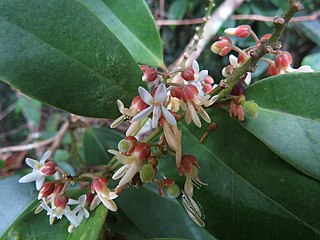
Xanthophyllum octandrum, commonly known as Macintyre's boxwood, false jitta, yellow boxwood or sovereignwood, is a slow-growing tree in the milkwort family Polygalaceae which has the potential to reach thousands of years of age. It is endemic to coastal northeastern Queensland, Australia.




